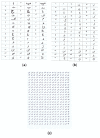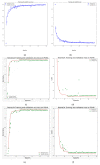Recognition of Pashto Handwritten Characters Based on Deep Learning
- PMID: 33080880
- PMCID: PMC7590197
- DOI: 10.3390/s20205884
Recognition of Pashto Handwritten Characters Based on Deep Learning
Abstract
Handwritten character recognition is increasingly important in a variety of automation fields, for example, authentication of bank signatures, identification of ZIP codes on letter addresses, and forensic evidence. Despite improved object recognition technologies, Pashto's hand-written character recognition (PHCR) remains largely unsolved due to the presence of many enigmatic hand-written characters, enormously cursive Pashto characters, and lack of research attention. We propose a convolutional neural network (CNN) model for recognition of Pashto hand-written characters for the first time in an unrestricted environment. Firstly, a novel Pashto handwritten character data set, "Poha", for 44 characters is constructed. For preprocessing, deep fusion image processing techniques and noise reduction for text optimization are applied. A CNN model optimized in the number of convolutional layers and their parameters outperformed common deep models in terms of accuracy. Moreover, a set of benchmark popular CNN models applied to Poha is evaluated and compared with the proposed model. The obtained experimental results show that the proposed model is superior to other models with test accuracy of 99.64 percent for PHCR. The results indicate that our model may be a strong candidate for handwritten character recognition and automated PHCR applications.
Keywords: Pashto handwritten character recognition; computer vision; convolutional neural networks; deep features fusion; deep learning.
Conflict of interest statement
The authors declare no conflict of interest.
Figures










References
-
- Fujisawa H. Forty years of research in character and document recognition—An industrial perspective. Pattern Recognit. 2008;41:2435–2446. doi: 10.1016/j.patcog.2008.03.015. - DOI
-
- Steinherz T., Rivlin E., Intrator N. Offline cursive script word recognition—A survey. Int. J. Doc. Anal. Recognit. 1999;2:90–110. doi: 10.1007/s100320050040. - DOI
-
- Plamondon R., Srihari S.N. Online and off-line handwriting recognition: A comprehensive survey. IEEE Trans. Pattern Anal. Mach. Intell. 2000;22:63–84. doi: 10.1109/34.824821. - DOI
-
- Arica N., Yarman-Vural F.T. An overview of character recognition focused on off-line handwriting. IEEE Trans. Syst. Man Cybern. Part C. 2001;31:216–233. doi: 10.1109/5326.941845. - DOI
-
- Khan N.H., Adnan A., Basar S. An analysis of off-line and on-line approaches in Urdu character recognition; Proceedings of the 15th International Conference on Artificial Intelligence, Knowledge Engineering and Data Bases (AIKED 16); Venice, Italy. 29–31 January 2016.
LinkOut - more resources
Full Text Sources

